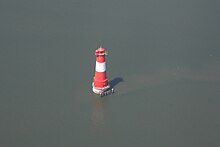Arngast lighthouse
| Arngast lighthouse | ||
|---|---|---|
| Arngast lighthouse | ||
| Place: | Arngast | |
| Location: | Sandbank in the Jade Bay | |
| Geographical location: | 53 ° 28 '53 " N , 8 ° 10' 54" E | |
| Height of tower base: | 36.27 m above sea level NN | |
|
|
||
| Scope knows: | 21.0 nm (38.9 km ) | |
| Scope green: | 17.0 nm (31.5 km ) | |
| Scope red: | 16.0 nm (29.6 km ) | |
| Function: | lighthouse | |
| Construction time: | 1909/1910 | |
| Operating time: | since 1910 | |
| International ordinal number: | B 1152 | |

→ General view of the region
The lighthouse Arngast is a 36.27 meter high lighthouse in the Jade Bay , a large bay in the southern part of the North Sea . The lighthouse, built in 1909 and 1910, is operated by the Wilhelmshaven Waterways and Shipping Office .
Geographical location
Within the Jade Bay, which is mainly filled with North Sea water via the Outer Jade and Inner Jade at high tide , the tower stands on a sandbank about 4.5 kilometers southeast of the city of Wilhelmshaven . This belongs to the same ridge on which the islands of the Arngast parish once stood elsewhere .
Building history
The tower was built in 1909 and 1910 to approach Wilhelmshaven and for orientation in the Jade Bay. It is also used for such in the fairways (buoy and prick because of) to Varel and Dangast .
After 112 heavy wooden piles (each around 8 meters long and 30 centimeters in diameter) had been put in place, the 36.27 meters high and 8.5 meters in diameter at the base of the lighthouse's steel construction was erected. The cost was around 200,000 marks. In 1975 and 1986 the wooden piles were reinforced by a sea-proof concrete coating.
beacon
Originally that was beacon of two 12 hp - diesel engines supplied with electric current. An approximately 6 km long submarine cable has been supplying the station with energy from Dangast since 1966 . Since 1968, the lighthouse can be controlled centrally via a telecontrol system from the traffic control center (formerly radio location center ) of the Wilhelmshaven waterways and shipping authority and is integrated into the North Sea light chain . The last lighthouse keeper retired that same year.
Technical specifications
| Main fire | Side fire | |
|---|---|---|
| Fire height | NN + 31.62 m | NN + 31.62 m |
| Light source | 1,600 watt lamp | 1,600 watt lamp |
| Luminous intensity in cd | 151,500 | 151,500 |
| Nominal range in sm | white 21; red 16; green 17 | white 10.1; green 7.5 |
| Classification | 12 sectors | |
| Identifiers | ||
| Celebratory fire | white, red, green | white, green |
| Lightning fire | white and green, flash every 3 seconds | - |
| Lightning fire | white, 2 flashes every 9 seconds | - |
| Broken fire | every 6 seconds | - |
tourism
In addition to the Roter Sand lighthouse, the Arngast lighthouse is one of the most famous and traditional lighthouses on the German North Sea coast. It was entered in the register of cultural and architectural monuments in 2003.
Excursions with a ship around the lighthouse can be booked from Dangast and Wilhelmshaven. Usually, on such an excursion, other attractions and sights are visited, such as the tanker discharge bridges and the naval port in Wilhelmshaven and the seal banks on the Jade. From Dangast it is possible to combine a trip around the lighthouse Arngast with a drive close to the south beach of Wilhelmshaven.
On July 7, 2011, the Federal Republic of Germany issued a € 55-cent postage stamp from the Arngast lighthouse ( Michel number 2935) as part of the lighthouses series .
literature
- Regulation DE No. 5, instructions for officers on the Arngast lighthouse, 1911
Web links
Individual evidence
- ^ Measurement table sheet from 1940 ( Memento from May 12, 2013 in the Internet Archive ) with the islands of Gr. Arngast and Kl. Anrngast as well as the light. Arngast .


